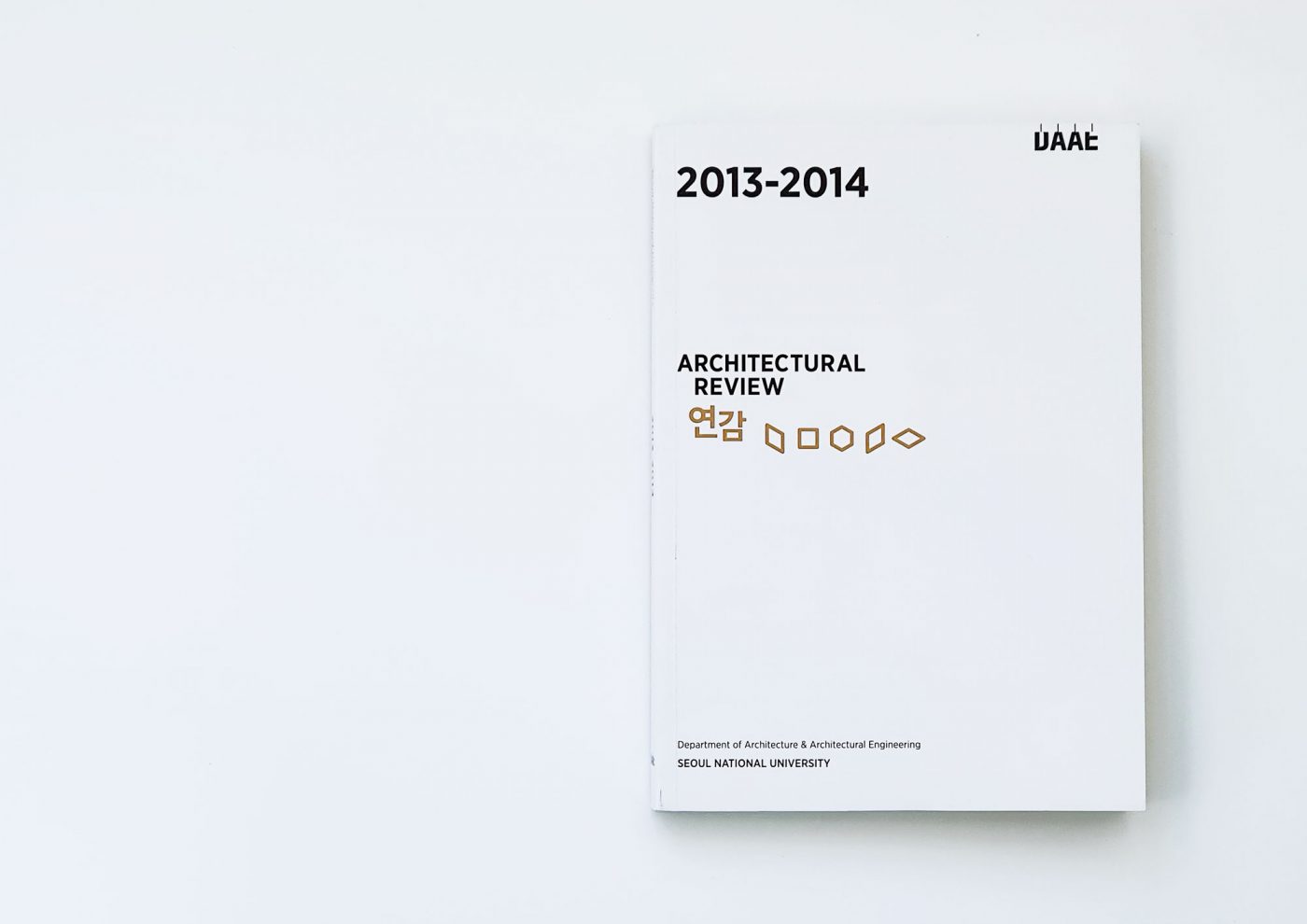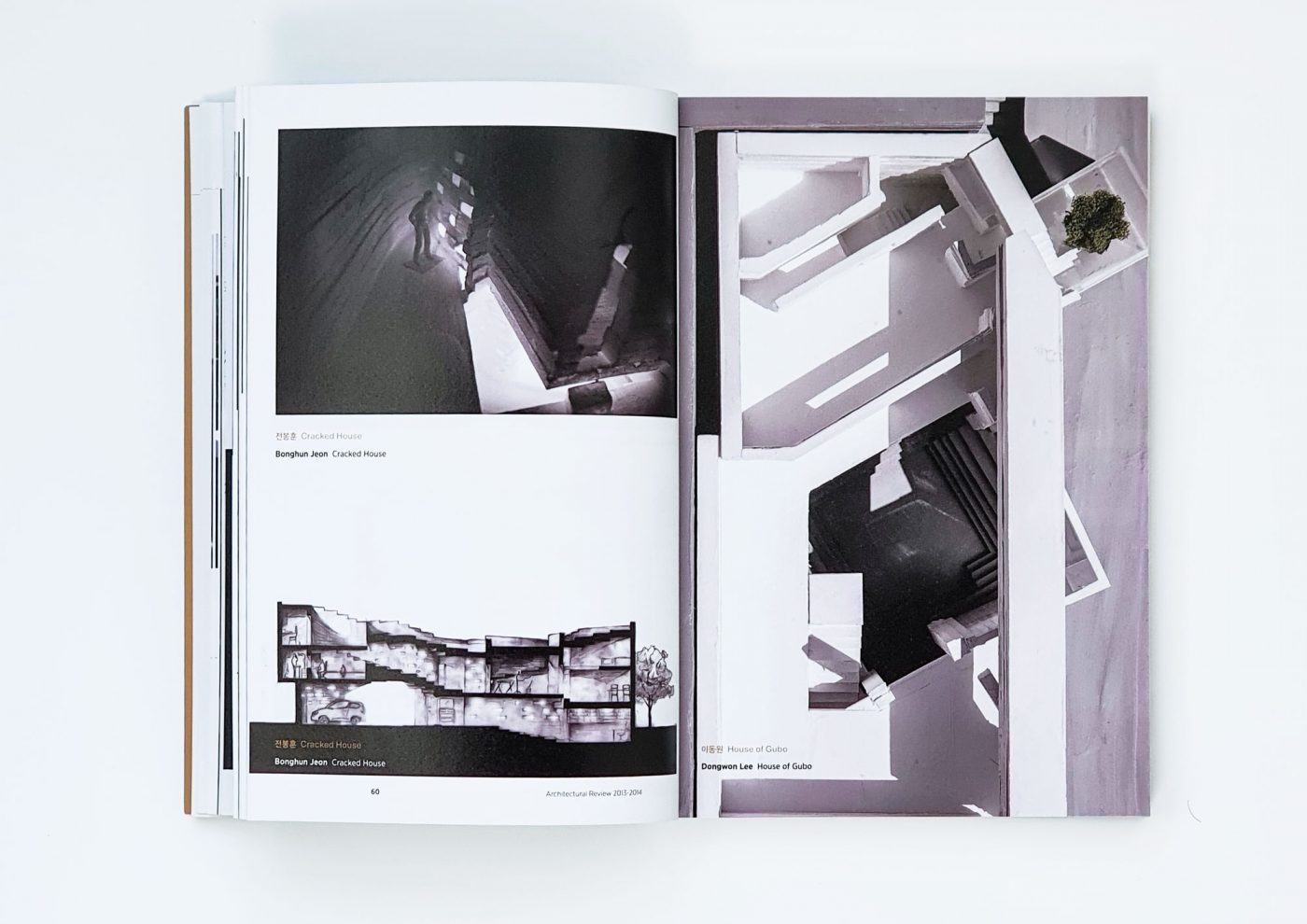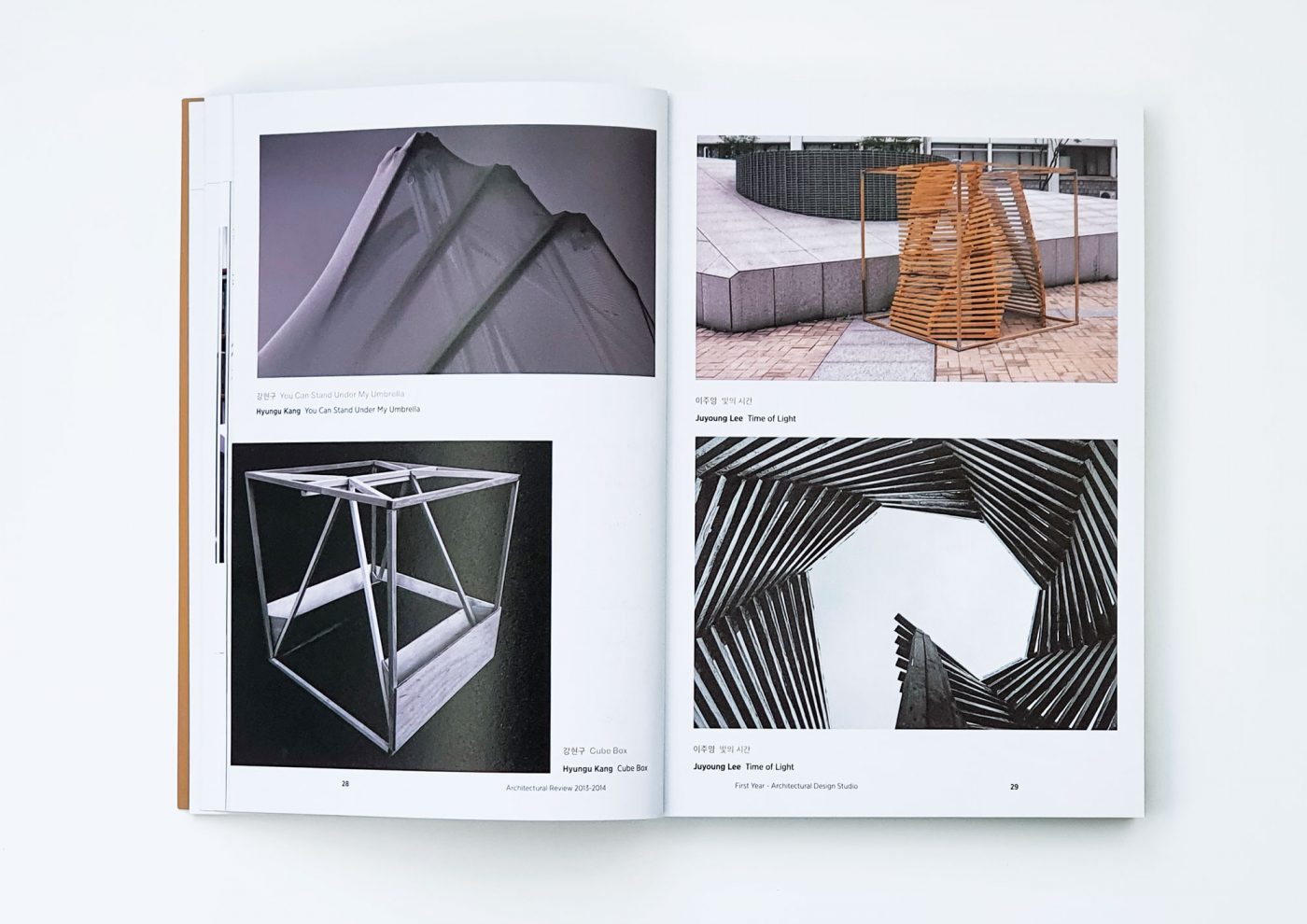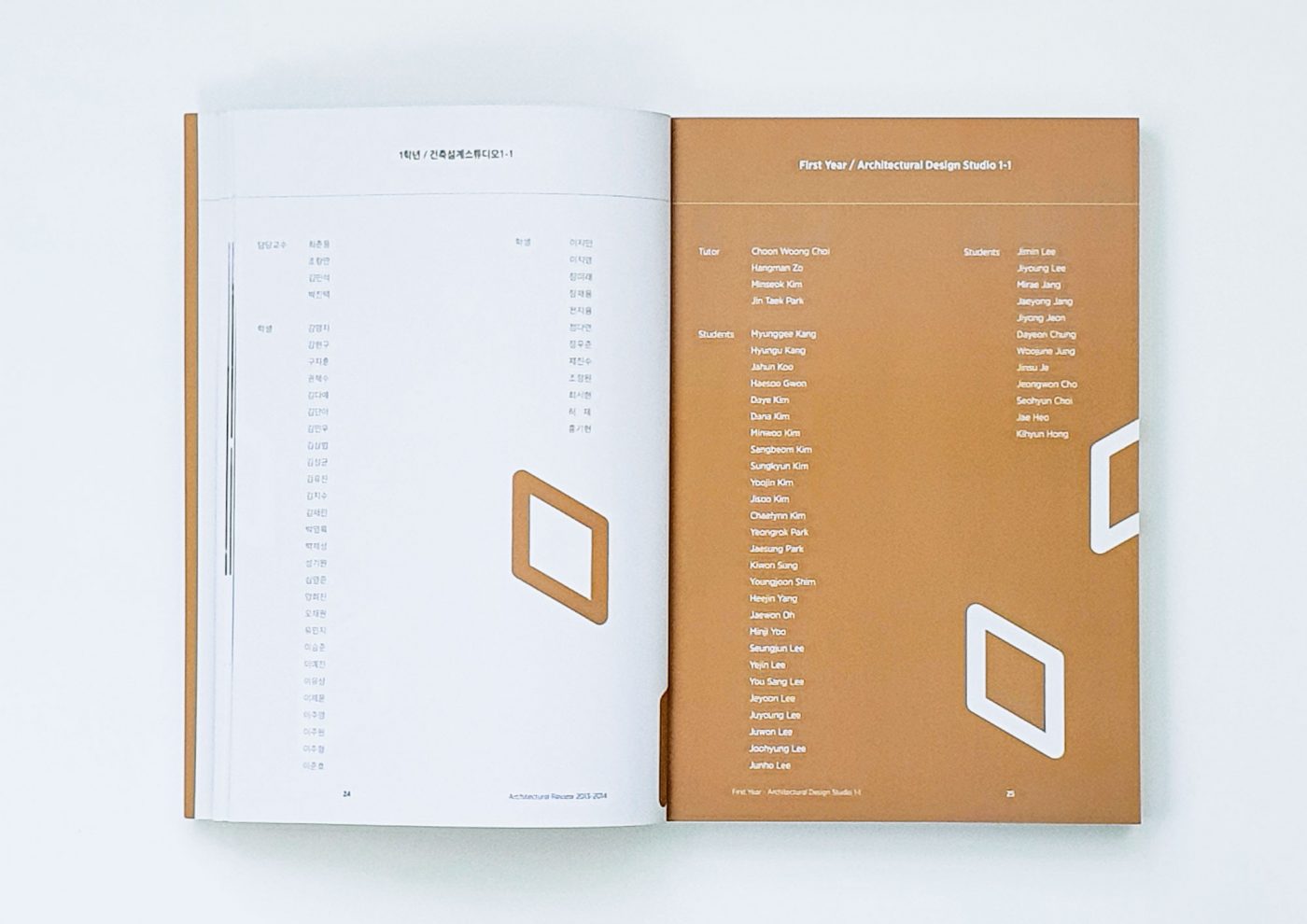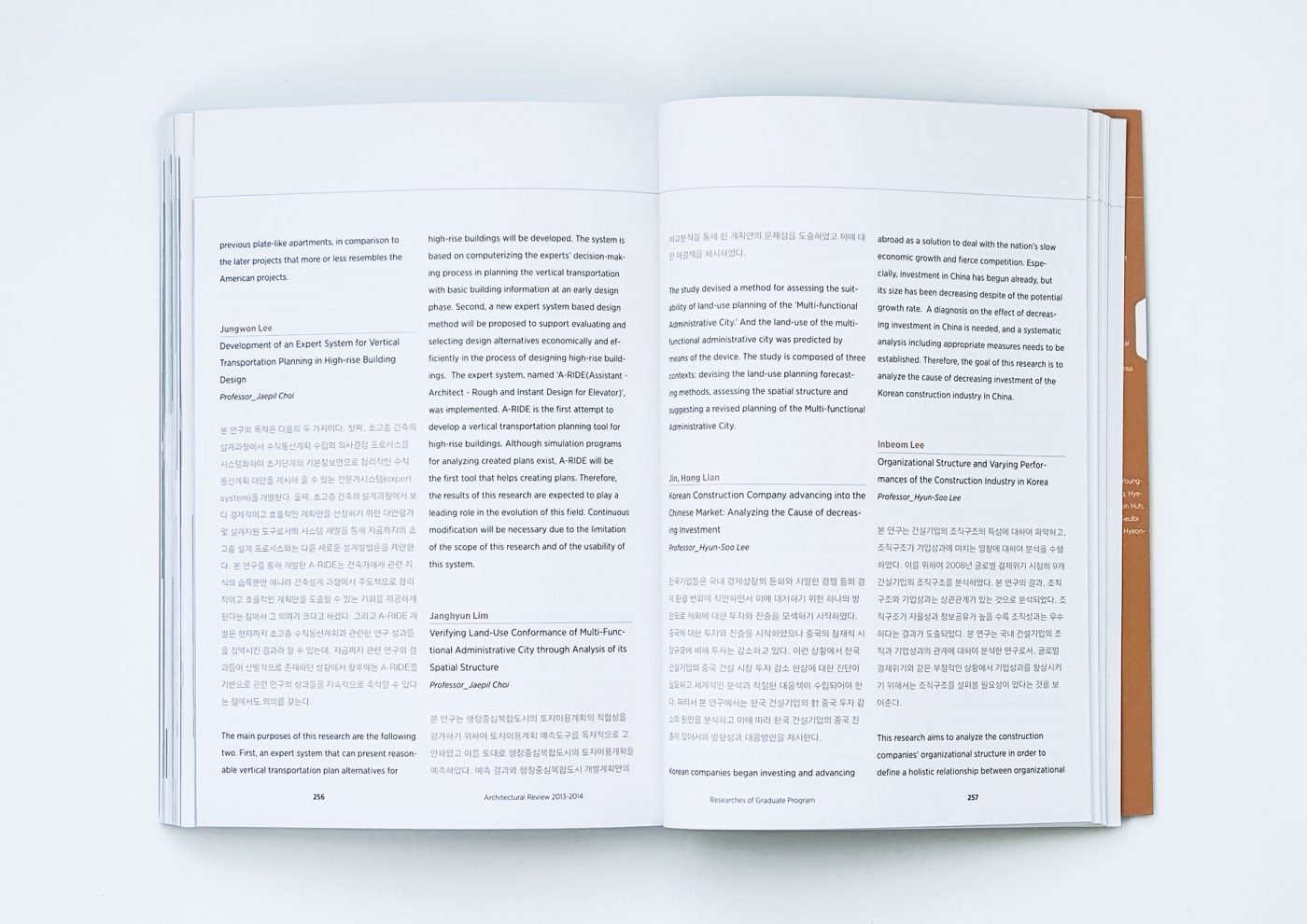SNU Architectural Review
2013 – 2014
2014, 1-1
건축설계스튜디오 1-1
“Things and BODY”
최춘웅, 조항만, 김민석, 박진택
강명지, 강현구, 구자훈, 권해수, 김다예, 김단아, 김민우, 김상범, 김성균, 김유진, 김지수, 김채린, 박영록, 박재성, 성기원, 심영준, 양희진, 오재원, 유민지, 이승준, 이예진, 이유상, 이제윤, 이주영, 이주원, 이주형, 이준호, 이지민, 이지영, 장미래, 장재용, 전지용, 정다연, 정우준, 제진수, 조정원, 최서현, 허 재, 홍기현
첫 스튜디오의 주제는 ‘세계에 대한 이해’ 이다. 세계를 독해의 대상인 텍스트로 설정하고 ‘신체’와 ‘사물’, 이렇게 두 가지 텍스트에 대해 탐구한다.
TEXT 1: 사물
우리의 일상생활에서 만나게 되는 사물들에 대한 섬세한 관찰과 이해를 바탕으로, 사물을 새롭게 해석하고 표현하는 훈련을 하는 과정이다. 사물에 대한 관찰에서 비롯된 구체적인 경험을 건축가의 표현수단인 도면과 모형을 통해 드러내고 표현한다.
TEXT 2: 신체
신체에 대한 탐구는 신체와 건축적 장치의 상호관계를 탐구하면서 다양한 시각과 관찰로 펼쳐진다. 1.8m 큐브를 캠퍼스 공간에 배치하고 대지의 상황에 반응하는 장치로서, 동시에 신체의 요구를 담는 장치로서 실제 스케일의 입체 공간을 제작한다.
두 번째 스튜디오에서는 우리 삶의 배경이 되는 도시를 탐색하고 그 속에서 장소를 만들어내는 작업을 하게 된다. ‘세계에 대한 이해’ 라는 주제는 계속되지만, 우리 삶의 구체적인 일상에 보다 가깝게 접근하면서 우리 도시가 갖고 있는 다양한 시간과 공간을 체험하고자 한다. 서울의 두 개의 지역을 탐구하고 도시와 건축이 만나는 장소에 작은 공간을 제안한다. 첫 번째 프로젝트는 도시공간에 대한 답사에 중점을 두는 반면에 두 번째 프로젝트는 ‘건축구조1’ 수업과 공동으로 진행하면서 구조방식을 고려한 건축공간을 제안하는데 중점을 둔다.
“Things and BODY”
The first studio focuses on “Understanding the World.” The world is approached as texts that are to be read. The two texts are: THINGS and BODY.
TEXT I : THING
Through fine observation and analysis of every objects, students develop their skills to creatively reinterpret the object and express those reinterpretations. They will then express their experiences of the object through architectural media such as drawings and models.
TEXT 2 : BODY-CUBE
This exercise explores the relation between the human body and architectural settings. They will design a 1.8m cubic space in full-scale, located within the university campus, that interacts both with the site conditions and the human body.
“Understanding of Urban Context”
The Second Studio is an exploration of the city, the scene of our daily lives, and creation of meaningful places within the city. While the theme “Understanding the World” is maintained, students will move on to the more concrete time and spaces of our lives. They will analyze two areas of Seoul, proposing small-scale spaces where the city and architecture encounter each other. The first project focuses on responding to the site, while the second project focuses on proposing a structurally sound architectural space, being run jointly with the lecture course ‘Building Structures 1’.
2013, 1-2
건축설계스튜디오 1-2
상보적인 공간
최춘웅, 조항만, 김민석, 박진택
권정호, 김경윤, 김나래, 김대홍, 김동현, 김동환, 김보경, 김삼송, 김성연, 김수연, 김아영, 김윤지, 김종현, 김주영, 박상준, 박 연, 박제현, 박혜영, 배중현, 서은섭, 서지윤, 송미정, 심 온, 안성룡, 안종규, 연승주, 예성빈, 유승재, 유예림, 이동원, 이지영, 임지은, 전봉훈, 정지문, 조민규, 채민기, 최하훈, 표구연, 한상범, 황진영
상보적인 공간
건축가의 간단한 정의는 인간의 삶을 위한 공간을 창조하는 업을 수행하는 사람일 것이다.
건축가에 의해 창조된 대상물은 건축/공간/장소 등이며 그것의 생명력은 창조물의 존재감에 의해 결정된다. 존재감을 획득하기에 가장 쉬운 방법 중 하나는 창조물이 만들어지고 놓이는 수많은 조건들과의 확연한 대비 Contrast 일 것이다. 강한 빛 아래의 부조가 뚜렷한 그림자와 음영과 함께 부조 자체도 그 모습을 온전히 드러내게 되는 것, 그 한가지 예이다.
스튜디오는 기존 도시의 한 부분에 이미 존재하고 있는 잠재적인 가능성 있는 공간을 팀을 이루어 답사, 기록, 분석하는 Warm-Up 과 거기에서 발견한 공간적 잠재성을 추상화하여 모델과 드로잉으로 재해석/ 재현하는 Part 1, 그리고 그 공간에 상보적으로 덧붙여서 새로운 기능과, 행태, 프로그램을 유발하는 건축적 장치를 제안하는 Part 2 로 이루어진다. 답사에서 찾아낸 공간과 덧붙여진 건축적 장치는 함께 떨어질 수 없는 쌍으로 작동하여야 하며, 서로 보완적이면서 극명한 대비를 이루는 것이어야 한다.
Making new community space by placing reciprocal spatial device into existing context. We briefly define “Architect” as a man who creates space to accommodate human lives. Architects elucidate their production in many ways borrowing words like architecture, space, place and etc. Fundamentally, the feeling of vitality is exposed by the existence itself. The easiest way to expose the thing itself is to contrast extremely with others and show differences within numerous conditions.
The studio will explore city and find out the urban space full of potential. Students interpret the site and abstract their findings through representation or reinterpretation with drawing and models first. Then they put reciprocal spatial device into the existing space on the second stage. The existing urban space and new device should work together in inextricable sets contrasting and complementing each other.
2014, 2-1
건축설계스튜디오 2-1
주택
최두남, 피터 페레토, 서을호
고요한, 권정호, 김대홍, 김아영, 김윤지, 김종현, 박상준, 박연, 박혜영, 서은섭, 송미정, 심온, 안성룡, 안종규, 연승주, 예성빈, 유승재, 유예림, 윤지만, 이동원, 이지영, 이희준, 임지은, 전봉훈, 정지문, 정하영, 제원모, 최하훈, 표구연
이 수업의 목표는 학생들로 하여금 디자인 과정에서의 기본적인 건축 개념과 친숙해질 수 있도록 함에 있다. 학생들은 이 과정에서 도시의 맥락과 프로젝트의 대상지를 분석하고, 개개인의 개성을 반영하는 심미관을 표출할 수 있어야 한다. 개인의 미학적 관점을 건축적 개념으로 발전시키며, 앞선 개념적 발전이 최종 디자인으로 도달할 수 있도록 한다. 프로젝트 대상지에 주택을 설계함으로써, 개념 도출에서 최종 설계안까지의 전 과정이 학생들의 적극적인 디자인 참여로 이루어지게 된다.
The objective of this course is to help students learn the process of design by encouraging them to get familiarized with the basic architectural concepts. Students are asked to carefully analyze the given context and the site, which are important parts of the design considerations, in the process of establishing architectural concepts that would reflect architect’s aesthetic vision. While designing a house, students are to be engaged in total design process: site planning, program analysisand building design.
2013, 2-2
건축설계스튜디오 2-2
-구조시스템의 디자인 잠재성
- 중세 수도원의 정신을 담은 공간
-건축설계개념을
최두남, 피터 페레토, 최춘웅
강승재, 김건희, 김나래, 김미소, 김은혜, 김혜인, 미약마르, 박민규, 배창현, 백남혁, 송경은, 송혜진, 신유진, 아이삭, 안연경, 원지원, 이건일, 이다은, 이승헌, 이영주, 이재헌, 전근우, 조원섭, 최윤하, 최태환, 하소영, 홍지현, 황문규
목표1
건물의 재료와 구조 시스템에 대한 집중적인 탐구를 통해 학생들은 다양한 구조 시스템을 통한 잠재적인 디자인적 가능성을 발견하고, 건물 재료에 대한 구축적인 의식을 함양하고 발전시키는 기회로 강의에 참여한다.
목표2
빛, 시간, 움직임의 상호 관계와 함께 음양 반전의 석고 주물 방식으로 공간에 대한 탐구를 하고, 피라네시의 판화 작업을 통해 영적 공간에 대한 리서치를 토대로 학생들은 중세 수도원의 정신에 부합하는 공간을 설계한다.
목표3
기본적인 건축 설계 개념을 소개하고 학생들로 하여금 특정한 설계 결과를 얻을 수 있도록 개인 작업 방식을 구축하는 방법을 장려한다. 일련의 탐구 과정과 설계 프로젝트를 통해 학생들은 건축의 언어에 보다 친숙해지고, 필요한 기술적, 이론적인 기술을 습득한다.
Object1
The objective of this course is to emphasize the importance of the technical aspect of architectural design by having students pay attention to building materials and structural systems. Students will have opportunities not only to examine the potential design possibilities of various structural systems but also to develop tectonic awareness of building materials.
Object2
Students will explore the space with the conception of how light, time and movement interact. The technique will be casting, where the positive space has to be inverted. Also students will explore Piranesi’s drawings. Students will design a spiritual retreat which corresponds to the spirit of medieveral monasteries through the findings from the formal research project.
Object3
This course will introduce basic architectural design concepts and encourage students to develop individual working methods to draw specific design solutions in each project. Through a series of research and design projects, students will become familiar with the language of architecture and acquire necessary skills, both technical and theoretical.
2014, 3-1
건축설계스튜디오 3-1
- 공동체의 만남과 집회를 위한 시설
- 도서관
- 건축과 동물성
김현철, 김승회, 최춘웅
강경국, 강승재, 기 릴, 김건희, 김나래, 김미소, 김보연, 김은혜, 김혜인, 김환기, 민지희, 박민규, 배의진, 배창현, 송경은, 신유진, 아이삭, 안연경, 유지민, 은 옥, 이건일, 이다은, 이영주, 이재헌, 이 학, 조나스, 최슬온, 최윤하, 최태환, 하 릴, 하소영, 허은석, 황문규
목표1
분명 다른 기능인데 그 공간의 형식이 비슷한 것들이 있다.각각의 유형은 건축기능의 분류상 완전히 다른 영역에 속해있다. 이 시설들의 공통점은 바로 ‘공동체의 만남과 집회를 위한 시설’이라는 것이다. 공동체를 위한 공간은 사적영역을 넘어 우리 도시의 많은 곳에 다양한 형식으로 존재한다. 다양한 시설들은 사적영역인 ‘집’이 만족시켜주지 못하는 공동체의 만남을 가능하게 해준다. 3-1 스튜디오에서는 대지, 프로그램, technology, 법규, 경제성, 방재 등, 건축을 생성하는 복합적인 matrix를 이해하고 다층적 스케일과 다양한 관점을 통해 건축을 생성하는 건축설계과정을 익힌다.
목표2
단순 사용자 건물 설계를 연습한 학생에게 다중 사용자 설계를 다룰 수 있도록 연습한다. 구조는 30mX30m 범위에 6mX6m 라멘 그리드 구조로 중규모 공간에서 다양한 사용자가 이용하는 공간을 설계한다. 공공 홀과 책 저장 물류처리 공간 등이 갖추어진 도서관 프로그램에 대해 숙지하도록한다. 무장애공간의 공간화에 대한 이해를 높이며 법규검토와 설계적용 연습도 실시한다.
목표3 - 건축과 동물성 / 카라 동물보호교육센터
비인간동물을 도시커뮤니티의 구성원으로 포함하는 확장된 영역 안에서 현대도시의 청결과 살균에 대한 기준을 보다 생물융합적인 지속가능성이 가능한 공생구조로 재해석하기 위한 설계를 시도하기 위해 동물성이라는 필터를 적용하는 것이 본 스튜디오의 목표였다. 인간동물과 비인간동물이 섬세하게 엮여진 생명의 폭 안에서 동등한 위치에서 생활하는 살아있는 도시를 상상하며 일상의 공간들을 비인간동물의 시각으로 재해석하는 것으로 시작된 프로젝트들은 동물보호단체 카라의 교육센터 계획으로 구체화되며 마무리 되었다.
Object1
The 3rd year design studio focuses on stepping from single-use buildings to public buildings. Therefore, a repetitive 6mX6m column-and-beam structural grid is introduced within a 30mX30m boundary, a medium scale design project with programs for various users. Students will practice this concept through the design of library, a synthesis of a public hall, book storage, logistics and etc. While the awareness to concepts of ‘barrier-free design’ and ‘universal design’ is emphasized, learning and application of building laws are also being introduced and practiced.
Object2
While the functions are clearly different, space may take on very simillar forms. The categories of each types are differentiated, and in terms of architectural function they belong to distinctive sections. Spaces for communities go beyond personal limits, and exist in diverse forms in our cities. Religion, enterprise, leisure, education… The limitation of communities being unable to meet in ‘housing’ is fulfilled by various facilities. The complex matrix of site, program, technology, code, economics and disaster prevention, that composes architecture should be understood.in constructive perspectives. In 3-1 architectural studio, students learn architectural process through multiple scale and various viewpoints.
Object3 - Architecture for Animality / The Center for Animal Welfare and Education
A challenge for this studio was to expand our understanding of urban communities to include non-human animals as well as humans. The modern city’s obsession with hygiene and sterility was challenged by applying a new filter of animality for assessing the biosynthetic sustainability. To formulate an updated vision of a more organic city, in which humans are but one among many participants in the intricately intertwined spectrum of life, students first created a visual catalogue of popular architectural imageries as re-imagined through an animal gaze, and then designed the new headquarters for KARA, or Korea Animal Rights Advocates, which was founded in 2002 to promote the welfare of animals, and educate the public about ethical treatment of animals. This course will introduce basic architectural design concepts and encourage students to develop individual working methods for arriving at a specific design solution. Through a series of research and design projects, students will become familiar with the language of architecture and acquire necessary skills, both technical and theoretical.
2013, 3-2
건축설계스튜디오 3-2
- 도시꼴(Urban Form) 설계
-건축 테크놀로지와 장소의 구축
- 낯선 것들의 조우
김현철, 조항만, 조남호, 전봉희
강원기, 김덕환, 김룡의, 김소영, 김태환, 문성훈, 민세원, 박민정, 박은정, 박정현, 박혜상, 송재영, 송현아, 신기훈, 이동민, 이동주, 이민재, 이신후, 이태규, 이현민, 이현우, 이희준, 장혜림, 전기원, 정연중, 차완희, 최선범, 하릴, 허경화, 허진아, 현은수
목표1
스튜디오 3-1에서 연습한 다중이용시설 설계를 확장하여 공연장의 특수공간과 시설설비를 고려한 공간설계 연습을 시행한다. 도시꼴(Urban Form) 설계를 통해 도시내 조형과 내부 공간의 접촉점을 모색하고 도시민이 모일 수 있는 커뮤니티 행위에 필요한 공간설계와 무대와 객석의 특수목적행위 공간 설계의 접목점을 찾는다. 도미노 구조 이론의 확대적용을 연습하며 장애인 소요공간과 방재공간의 건축적 해결방안을 동시에 연습한다.
목표2 - 건축 테크놀로지와 장소의 구축
구축성(Tectonic)은 건축만이 가지는 고유한 성질이며, 이를 통해서만 외부적인 담론이 건축에서 실현될 수 있다. 건축이 대지(site)와 유형(type), 구축성(tectonic)의 지속적인 상호작용의 결과라고 한다면, 전자는 다양한 담론으로부터 현대적 경향을 가져왔지만 구축성은 도구적 수단에 머물러왔다. 스투디오 과제는 물리적인 구축을 통해 비물질적인 다양한 개념을 표현할 수 있는 가능성을 보여줌으로써 학생 스스로 그 개념의 생산자가 되게 하려는 의도에서 비롯됐다. 전통적인 설계 과정에서는 대지와 프로그램, 즉 외부적인 조건이 주어지면서 시작 된다. 건축가들은 형태와 공간을 만든 후, 재료와 시공법 등을 검토한다. 이 스튜디오는 과정을 역방향으로 진행한다.
목표3 - 낯선 것들의 조우
현실 속에서는 만나기 어려운 두 가지 이상의 프로그램을 한 사이트에 넣어 그 화학 작용으로 새로운 형식의 다중이용시설을 디자인한다. 본 스튜디오는 프로그램, 패턴, 공공/공용 공간의 세 가지 주제어를 기반으로 진행된다. 독일의 철학자 하이데거는 일찍이 “낯선 것과의 조우에서 이성이 시작된다.”라고 하였고, 소설가 황석영은 “지루함은 죽음이고 저지르면 살아난다.”라고 적은 바 있다. 끊임없이 진화하는 현대의 삶에서 지루해진 일상이 그 익숙함으로 인해 ‘새로움’이라는 창의의 동력을 더 이상 공급하지 못하는 지금, 낯선 것과 생경한 만남은 혁신적인 디자인에 필수적이다.
Object1
Developing from the basis of Architectural Design Studio 3-1, the design practice of theatre is being conducted. Through urban form design, the interrelation between urban form and interior spaces is being explored, creating a gathering space for the urban community. Connections and relations between performance stage and seating plane are also being studied. Students will also be introduced to the concept of Maison Dom-Ino by Le Corbusier, barrier-free design and disaster prevention design through the sustematic design practice.
Object2 - Architectural Technology and Building Placeness Tectonics is the unique characteristic of architecture. External discourses can be materialized only through tectonics. Architecture is an outcome of continuous interaction among sites, types, and tectonics; sites and types brought the modern trend throughout various discourses, while tectonics remained as the means of tools. By showing the possibility of expressing various immaterial concepts through tangible techtonics, this studio aims for letting the students become the producers of those concepts. The traditional design process begins with the given site and specific programs, that is external conditions. Architects articulate the form and the space first, and they consider the materials and construction methods afterwards. This studio conducts these two steps vice versa, or at the same time.
Object3 - Encountering Unfamiliar Programs on Public Spaces with Patterning Students propose on innovative form of the multipurpose facility based on three key words; Program, Pattern, Public Space. One site accommodates more than two different programs which have no chance to meet and be combined together in our everyday life. This unfamiliar encounter of different programs allows us do creative gesture toward monotonous living environment through the heterogeneous interaction. Facing “Newness”, contemporary cities, full of dullness, could regain their vitality. Then, the city liberates people from delusion.
3
건축재료계획
새로운 물질성에 대한 탐구
김승회
강소진, 김건희, 김미소, 김보연, 김우재, 김은혜, 김지윤, 김혜인, 김환기, 민지희, 박미희, 배의진, 배창현, 송경은, 신유진, 아이삭, 안연경, 유지민, 이건일, 이다은, 이영주, 이재헌, 이학, 최슬온, 최윤하, 최태환, 최하훈, 하소영, 함영걸, 허은석, 황문규
건축가에게 있어서 재료는 건축의 요소로 이해되는 것이 아니라 건축 그 자체이다. 그러므로 재료는 설계의 마지막 단계에서 결정되는 것이 아니라 첫 단계에서부터 대지와 프로그램과 함께 총체적으로 다루어져야 한다. 재료계획의 수업을 통해서 재료의 성질과 그 사용 방식에 대해 이해한다. 그 이해를 바탕으로 재료와 관련된 건축디테일을 탐구하고 실제 건축공간과 재료의 관계를 살퍼본다. 한편으로 재료의 본질과 개념에 대한 숙고를 바탕으로 새로운 물질성에 대한 탐구가 이루어진다. 목재와 유리, 금속등 구체적은 재료로 오브제를 만드는 과정을 통해 재료와 물질에 대한 속성과 물성에 대한 독창적인 해석과 창의적인 표현을 실험한다. 이러한 재료에 대한 이해를 바탕으로 그것이 실제로 어떻게 건축물을 통해 구현되는지 구체적인 사례를 통해 탐색하고 재료에 관한 총체적인 이해와 전망을 습득한다.
For the architect, the material is not considered as the element of architecture; it is architecture itself. Therefore, the material should not be decided at the end of the design process, but should be handled at the beginning with site and program. Through this course, students understand the character and usage of architectural materials. And based on this, they will learn about mateirals and architectural details, and think about relationship between actual architecture space and materials. On the other hand, new materiality will be explored by consideration about concept and essence of materials. By making objects with real materials like wood, glass, concrete, Students experiment materials, materiality of substance, creative expression and original interpretation about a property of matter. Through this understanding of materials, students will get a comprehensive understanding and prospect by cases where the use of new materiality is realized in building projects.
2014, 4-1
건축설계스튜디오 4-1
TRANSFORMATION VS PRESERVATION
: Hangzhou, China
피터 페레토, 조항만, 김정임
강원기, 권기홍, 김다은, 김수나, 김진회, 김태환, 문성훈, 박민정, 박성경, 박찬이, 박혜상, 송재영, 신기훈, 신현희, 이동민, 이동주, 이민홍, 이세진, 이현민, 이현우, 이형빈, 이희준, 장재윤, 정연중, 조지현, 최선범, 코르둘라, 허경화, 허진아, 현은수, 황희진
TRANSFORMATION VS PRESERVATION
아시아 지역은 도시 계발을 할 때 역사적인 발전의 흔적들을 자주 제거해왔다. 특히 30년 동안 공격적인 경제 정책을 펴온 중국은 이러한 지역, 토착의 전통 제거현상이 뚜렷하였다.
서울대학교 디자인 스튜디오는 중국의 도시, Hangzhou를 싸이트로 설정한다. 이곳은 중국 동부 절강 지역에 있으며, 2000년의 역사를 지니고 있다. 현재는 중국 건축가 왕슈가 이곳에 거점을 가지고 있다. 그는 2012년 프리츠커 상을 수상했다. 그의 작품은 지역성을 반영하는데, 그 지역에 존재하고 있는 타이폴로지들을 연구하며, 재료의 재사용에 대해 연구한다. 싸이트는 동일할 것이며, 각자 교수님들은 각자의 주제, 목표를 가지게 될 것이다.
TRANSFORMATION VS PRESERVATION
The notion of Tabula Rasa, for so often the preferred form or urban development in most Asian cities, is rapidly being questioned on the grounds of eradicating the traces of historical development. No country testifies to this eradication of local heritage more than China in the last 30 years with their aggressive economic policies. Our joint Design Studio will be based in Hangzhou, China. Hangzhou, the capitol Zhejiang Province in Eastern China, has a long history of over 2000 years. In recent years it has become the home to the renowned Chinese architect Wang Shu, who in 2012 won the prestigious Pritzker prize with the work that can be characterized by an increased awareness of the local, both in learning from existing typologies and reusing existing materials. Each professor will have their own specific agenda but will be working on the same site in Hangzhou.
2013, 5-2
건축설계스튜디오 5-2
디자인 프로세스 : 기획에서 디자인, 빌딩시스템, 디테일에 이르기까지
김승회, 손석훈, 안우성, 이규상
강경국, 고경훈, 권기홍, 김상, 김준홍, 김환기, 박다솔, 방누리, 백도현, 서영수, 신현재, 심규대, 윤여춘, 이병준, 이진원, 장웅기, 전홍철, 정인철, 정혜윤, 최민현, 한상후, 홍다솔, 황민진
5학년 2학기 스튜디오의 전 과정을 통해 실제적인 설계 프로세스를 수행한다. 기획단계에서부터 디자인, 빌딩시스템, 디테일에 이르는 전체적인 디자인 프로세스를 진행하면서 각 디자인 단계에 따른 건축적 개념의 전개 방식과 디자인 과정을 익힌다. 종합적인 설계의 과정을 실행하고 프로젝트의 각 단계별 목표에 따라 결과물을 완성한다.
The students will perform practical design process via the whole program of this studio. Starting with working out a scheme, the students will go through design development, building system and details step by step. Going through all this steps, Students will learn how to deal with the architectural concept and process of design. Performing total process of planning, students will complete the architectural project achieving the aim of each step.
